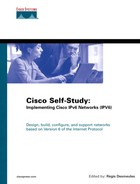H - J
- IANA.
Internet Assigned Numbers Authority. An organization operated under the auspices of ISOC as a part of IAB. IANA delegates authority for IPv4 and IPv6 address space allocations. IANA also maintains a database of assigned protocol identifiers used in the TCP/IP stack, including autonomous system numbers.
- IETF.
Internet Engineering Task Force. A task force consisting of more than 100 working groups responsible for developing Internet standards. The IETF operates under the auspices of ISOC.
- IPng.
IP next generation. The former name of the IETF working group that designed the technical specifications for IPv6. This IETF working group was renamed IPv6 in 2001. IPng is also the former name of the IPv6 protocol.
- IPv4.
Internet Protocol version 4. A network layer protocol in the TCP/IP stack offering a connectionless internetwork service. IP provides features for addressing, type-of-service specification, fragmentation and reassembly, and security. IPv4 is based on a 32-bit address scheme. IPv4 is documented in RFC 791.
- IPv4-compatible IPv6 address.
A special unicast IPv6 address used by IPv6 transition and coexistence mechanisms. An IPv4-compatible IPv6 address is represented by the prefix ::/96.
- IPv4 Internet.
The current production unicast IPv4 Internet. The IPv4 Internet is also known by non-IPv6 users as the Internet.
- IPv4-only node.
A node that runs only an IPv4 stack.
- IPv6.
Internet Protocol version 6. Introduced by the IETF in 1992, IPv6 appears to be a fundamental and well-engineered solution to the IPv4 addressing space shortage. IPv6 is significantly more efficient than IPv4. IPv6 is based on a 128-bit address scheme. IPv6 provides nodes with multiple types of addresses and has a basic header of 40 octets and several optional extension headers and mechanisms.
- IPv6 Internet.
The growing production unicast IPv6 Internet, which includes the 6bone.
- IPv6-only node.
A node that runs only an IPv6 stack.
- ISATAP.
Intrasite Automatic Tunnel Addressing Protocol. A transition and coexistence mechanism that tunnels IPv6 packets in IPv4 within an administrative domain to create one virtual IPv6 network over an IPv4 network. See draft-ietf-ngtrans-isatap-12.txt.
- IS-IS.
A routing protocol based on the OSI routing protocol IS-IS, but with support for IPv4, IPv6, and other protocols. Integrated IS-IS is an IGP protocol. See draft-ietf-isis-ipv6-05.txt.
- ISP.
Internet service provider. A company that provides Internet connectivity and IPv6 address space to other companies, organizations, and individuals.
